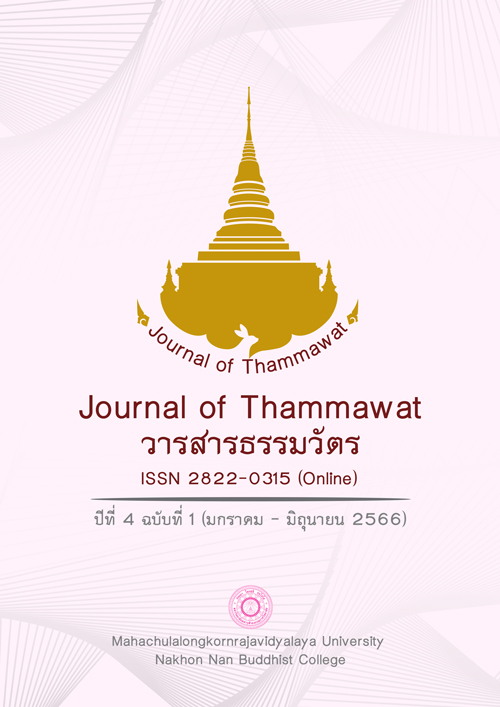A Guideline of The Management Vipassana Meditation with Sappaya Priciple Performed by Wat Pacharoenrat Meditation Center, Pathum Thani
Main Article Content
Abstract
The article had investigated on 3 objectives: 1) study the 7 Sappāya principle in Theravada Buddhist scriptures, 2) study the general conditions of Vipassana meditation management performed by Wat Pacharoenrat Meditation Center, Pathum Thani province, 3) proposal of the guideline for promoting Vipassana meditation management based on 7 Sappāya teaching performed by Wat Pa Charoen Rat Meditation Center, Pathum Thani province. The researcher used a qualitative method by in-depth interviews to collect data from general users and 18 experts and focus group discussions for data collecting and analysis and compiled in descriptive type. The results showed that;
1) Sappāya means what is comfortable, conducive, and helpful for the certain concentration consisting of 7 themes: Āvāsasappāya, Gocārasappāya, Phassasappāya, Puggalasappāya, Bhojanasappāya, Utusappāya, and Iriyasappāya. Sappāya. These good environments become key factor of well-being contribution, and leading goal, Nibbana attainment.
2) Wat Pa Charoenrat has been managed based on 7 Sappaya principle. At the present, the Meditation Center has comfortable buildings, and area, Dhamma garden, green trees that makes the center more pleasant. Its administrators and lecturers are experts in both moral and practical skills, and able to teach with certain meditation pattern.
3) Guidelines for promoting the management of meditation practices revealed that the center should make a progressive plan, goals for improving the effective management to followers by implying 7 Sappaya including places, transportation, propagation, officer, food, environment for the best practice results in advance and enabling to apply the teachings and learned experiences in daily life and society development in future.
Article Details

This work is licensed under a Creative Commons Attribution-NonCommercial-NoDerivatives 4.0 International License.
References
พระพรหมคุณาภรณ์ (ป.อ. ปยุตฺโต). (2556). พจนานุกรมพุทธศาสตร์ ฉบับประมวลธรรม. กรุงเทพฯ: ผลิธัมม์.
พระพรหมคุณาภรณ์ (ป.อ. ปยุตฺโต). (2556). พจนานุกรมพุทธศาสตร์ ฉบับประมวลศัพท์. กรุงเทพฯ: ผลิธัมม์.
พระพุทธโฆสเถระ. (2551). คัมภีร์วิสุทธิมรรค. แปลโดย สมเด็จพระพุฒาจารย์ (อาจ อาสภมหาเถระ).
(พิมพ์ครั้งที่ 10). กรุงเทพฯ: ธนาเพรส.
พระราชรัตนมุนี (ชัยวัฒน์ ปญฺญาสิริ).(2538). การจัดสาธารณูปการและสาธารณะสงเคราะห์ของวัด. กรุงเทพฯ: โรงพิมพ์การศาสนา.
พระโสภณมหาเถระ (มหาสีสยาดอ). (2555). มหาสติปัฏฐานสูตรทางสู่พระนิพพาน. แปลและเรียบเรียงโดย พระคันธสาราภิวงศ์. กรุงเทพฯ: ประยูรสาส์นไทยการพิมพ์.
สมเด็จพระพุทธชินวงศ์ (สมศักดิ์ อุปสโม). (2555). อริยวังสปฏิปทาปฏิปทาอันเป็นวงศ์แห่งพระอริยเจ้า. กรุงเทพฯ: ประยูรสาส์นไทยการพิมพ์.
พระวีระศักดิ์ สุวรรณวงศ์. (2556). แนวทางการจัดการวัดสันติสุขตามหลักสัปปายะ 7 : กรณีศึกษาวัดธารน้ำไหล จังหวัดสุราษฎร์ธานี. วารสารสันติศึกษาปริทรรศน์ มจร, 3(2), 98-114.
พุทธชาติ แผนสมบุญ, สิริวัฒน์ ศรีเครือดง และ โกศล จึงเสถียรทรัพย์. (2566). รูปแบบการจัดการเรียนรู้อาชีพและทักษะอนาคตสำหรับวิทยาลัยอาชีวะและเทคนิคยุคชีวิตวิถีใหม่. วารสารสหวิทยาการมนุษยศาสตร์และสังคมศาสตร์,6(1), 484-499.
Damnoen, P. S., Siri, P., Supattho, P. S., & Kaewwilai, K. (2021). The Development of Student Characteristics in According to the Nawaluk Framework of the Buddhist integration of Buddhapanya Sri Thawarawadee Buddhist College. Asia Pacific Journal of Religions and Cultures, 5(2), 126–135.
Rattanawong, N. (2023). The Formulation of Model for Enhancing Oral Linguistic Performance of Teaching English Major Students of Mahachulalongkornrajavidyalaya University, Phrae Campus. Journal of Educational Management and Research Innovation, 5(1), 211–222.


